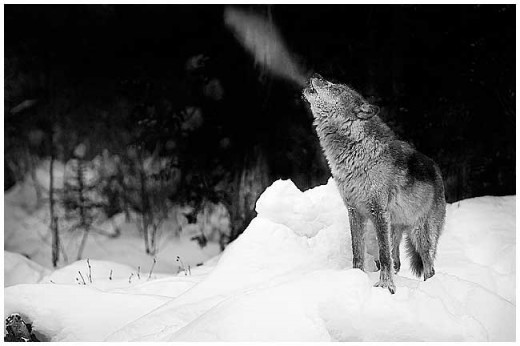Tips To Survive A Wolf Attack
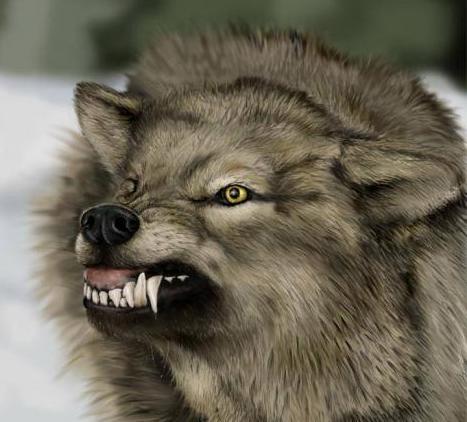
Facts About The Wolf:
If you want to know how to survive a wolf attack it's best to know valuable information about your attacker.
The wolf is, without a doubt, the largest member of the canine family. Their color range from black or gray to all-white. The wolf is ancestor to the domesticated dog and resembles malamutes.
Wolves are starting to make a comeback in Northern Rockies, the Great Lakes, and Southwestern United States.
Wolves diet consist of large hoofed animals, like deer, moose, caribou and elk. They have been known to eat rabbits, and other small prey. Wolves can be scavengers and will eat animals that have died to causes such as disease or starvation.
The population of wolves are estimated to be around 200,000 in 57 countries and compared to over 2 million in previous times. There is around 7000 to 11,000 wolves in Alaska and a little more than 5000 in the United States.
Wolves once ranged throughout all of North America but were killed out in most of the United States by the 1930s. Today their area of range has been confined to Canada, Alaska, Idaho, Michigan, Montana, Minnesota, Wyoming, and Wisconsin. Mexican wolves are found in Arizona and New Mexico.
A reintroduction of wolves in the Yellowstone National Park in 1995 makes this park a favored area to see wolves in their natural habitat.
Wolves hunt and travel in packs of up to 7 or more animals on average. Packs usually consist of the alphas which is the mother and father, their off-springs (which included pups), and several other young animals. The alpha male and females are known as pack leaders. The Alphas choose dens, track and hunt prey, and establish the pack's territory. Wolves have close relationships with their pack and develop strong social bonds. These animals show deep affection for members of their family and will often sacrifice themselves to protect the pack.
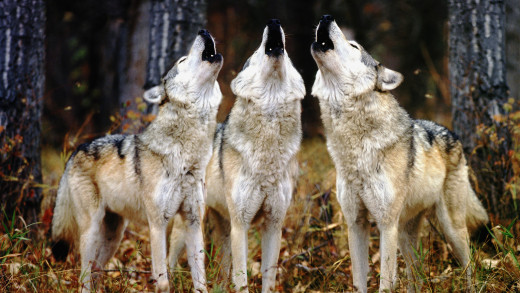
Wolf Attack on Humans
Encroachment into wolf territory leads to loss of habitat and prey for the wolf. The most common threat for the wolf is conflict with humans over livestock. This is rare but does happen occasionally. However, the greatest threat to the wolf is humans fear and misconceptions about the species. So many myths tend to lead to misunderstandings and put a stigma of danger about the creature. Myths involving the supernatural have also been associated with the wolf.
The government of India reported over 100 human deaths by the wolf in one year during the 1980s.
There are four reasons for wolf attacks on humans:
- Rabies
- Walking into a scene where wolves have a fresh kill or disturbs the chase of a prey animal causing the wolves to lose their anticipated food. This causes the wolf to turn and chase the human in the heat of the moment.
- Extreme hunger. As with any other carnivore, the wolf, if starving, will attack almost any animal for a food source, including humans. Many times a wolf that has killed or attacked a human, if he is found not to have rabies, is usually starving.
- Familiarity/Disposition. This could be several things. If a human feeds a wild wolf this causes the wolf to lose his natural fear of man. The next time the wolf sees a human he associated a human with a food source. If the human doesn't feed him he will attack the human as the food source. Another is a zoo setting. Captive wolves can be particularly aggressive and again loses his fear of man. Wolves raised as pets or in zoos are well documented on attacking and killing humans.
Attack on Humans:
- In August, 1996, the Delventhal family from Pittsburgh, Pennsylvania, spent several days on a family vacation in Algonquin Provincial Park, which is one of the several areas where people are encouraged to "howl" at the wolves hoping to get a response back from the wild wolves in the area. The group were answered back by the howl of a lone wolf. That night the Delventhals made the decision to sleep under the stars. Young Zachariah Delventhal was sleeping when suddenly he awoke to excruciating pain in his face. A single, lone wolf was dragging him from his sleeping bag by his face. Zach screamed in pain. His Mother, Tracy, raced to her son's side and picked him up. His blood soaked her thermal shirt. Tracy screamed in fear for her husband's help. Tom leaped from his sleeping bag and charged the wolf. The wolf retreated for a brief moment then charged again at Tracy and young Zach. These charges were continuous. Finally the wolf disappeared into the night. With a flashlight, Tom, looked at his young son's wounds. The little boy's nose was crushed, his right cheek was torn and dangling, and parts of his mouth were torn away. Blood gushed from extensive wounds below his eyes, and the lower section of his right ear was missing. Young Zach was rushed to the hospital in Toronto where a plastic surgeon reconstructed the child's face. Zach required over 80 stitches to his face alone. Canadian officials captured and destroyed the wild male wolf. Since then no further attacks have occurred.
- An Athabascan Indian, Paul Tritt, was attacked by a lone wolf in Alaska while working a trap line. He was setting a snare, as he looked up he saw a wolf lunging at him. He was able to throw his arm up in front of his face and it was bitten severely by the wolf. As a struggle ensued, Tritt was able to get to his sled, grab his gun and kill the wolf. A companion, Nathaniel Frank, helped Tritt wash his wounds with warm water. His companion took Tritt to Fort Yukon to be seen by a doctor. Tritt's arm healed but he never regained full use of it. However, several years later, the arm developed severe problems related the attack and had to be amputated.
- A six year old boy, John Strenglein, and his nine year old friend were playing outside his family's trailer at a logging camp in Icy Bay, Alaska when a lone, wild wolf came out of the woods toward the boys. The boys ran. The wolf quickly attacked young Strengein from the back, biting him viciously on the buttocks and backside. Adults nearby, hearing the boys, came and chased the wolf off. The wolf returned a few minutes later and had to be shot. According to the Alaska Department of Fish and Game Officials, the wolf was healthy and attacked without being provoked. The young boy was flown to Yakutat and received care for his wounds. After being released from care the boy had to be readmitted due to infected wounds.
- In Iran an armed policeman, Gendarme, mounted on a horse, was chased by three wolves. In time he had to get off his horse to use the bathroom. He thought he had lost the wolves so he left his rifle on the horse. Unfortunately, the wolves returned causing the horse to break lose and run with the weapon. The wolves devoured Gendarme leaving gnawed bones and wolf tracks.
- The official Zinhua News Agency in China reported that a peasant woman, Wu Jing, snatched her two daughters from the jaws of a wolf and fought with the beast until rescuers arrived. Wu slashed at the wolf with a sickle and caused the wolf to drop one daughter, but the wolf grabbed her sister. It was then Wu wrestled with the wolf until herdsmen arrived and drove the lone wolf away. This incident occurred near Shenyang City, about 380 miles northeast of Beijing.
- In the province of British Columbia a forester was checking some timber for harvest in the 1980s. He was approached by a pack of wolves. The man yelled at the wolves in an attempt to frighten them away. Instead, the wolves began to charge him in a threatening manner. He was able to climb a nearby try for safety. The wolves remained at the base of the tree waiting. The forester was able to contact his base. When the call was received by the base, two conservation officers with the Ministry of Environment were flown to the area by float-plane to rescue the forester. When the officers arrived, the forester was still up in the tree and one lone wolf remained, apparently the pack leader. The officers shot at the wolf and missed. The wolf ran for cover in the woods and started circling near the officers and howling. After a few more missed shots the wolf was finally shot and killed. Later the wolf tested positive for rabies. It appeared the attack was driven by hunger and sickness. The animal was found to be abnormally thin.
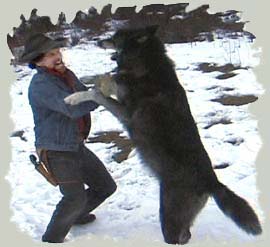
A U.S. trained Biologist, Rashid Jansheed, was the game director for Iran. In his book, The Big Game Animals of Iran (Persia), he made several references to attacks by wolves on humans. Jamsheed says that for a millennia people reported humans being attacked and killed by wolves. In the winter, when wolves are starving, they grow more bold and have been known to enter villages and kill people in broad daylight, right in the busy streets. In Iran, apparently, there are many cases of wolves attacking and running off with small children.
Unfortunately, there are many, many cases of wolf attacks on humans. In fact, there are so many I could never list them all in an article as this one. However, I can give you tips on what to do if you are ever the target of such an attack.
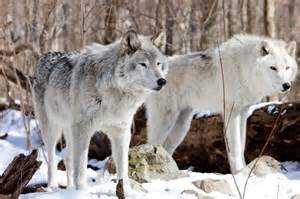
How to survive if you are being attacked by a wolf or a pack of wolves
- In the winter, wolves tend to chase their prey into deep snow or into frozen lakes. They tend to lead their prey to surfaces where the hooves of their victim sink or slide. A wolf has a large padded foot giving him a tremendous range-of-movement advantage in these areas. If you see a wolves around you, walk slowly toward solid ground. Do not crouch down and do not run. Even during the warmer months, wolves will chase prey over solid ground and have burst of speed as fast as 35 miles per hour over short distances. You cannot, no matter how hard to try, outrun a wolf. The feasible thing to do is to stay clear of muddy areas and move to solid terrain.
- Observe the wolves' posture. A wolf can attack from any position, but if his tail is straight up in the air and his ears are pricked up, this is a clear signal of dominance and an indication that the wolf is about to attack.
- Wolves are normally timid around humans and have a strong flight response. If you charge one member of the pack and yell loudly you may scare it and the other members will run away.
- If the wolves continue to attack, throw rocks and sticks at the wolves closest to you .Wolves tend to attack lower portions of their victim's bodies in an attempt to bring them to the ground. Hit or kick the wolves as they approach your legs until you scare them off.
- DO NOT RUN. Running from a wolf will only bring out their instincts to chase you. As mentioned above, you cannot outrun a wolf, it's best to stand your ground and fight back. If you run, the wolves will catch you and bite at your legs from behind, leaving you helpless in defending yourself. Stand and face them and fight back.
- If a high tree is nearby, back up to the tree slowly and climb it quickly. Wolves cannot climb trees. They may wait for a long period of time for you to come back down, but stand your ground. Climbing a tree has worked before in attack cases.
- If you are hiking in wolf territory always bring pepper spray along. Pepper spray will frighten away any animal. Although, pepper spray has been used in the past on attacking wolves and just stops them for a few minutes, it may give you just enough valuable time to get away or climb a tree.
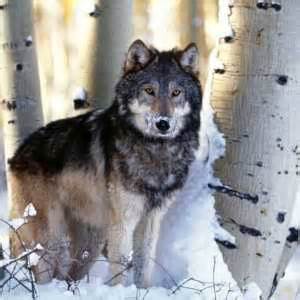
Be Fully Aware
- Wolves in captive are more likely to attack humans than wolves in the wild. Attacks are often a dominance display. Captive wolves will attack in efforts of being the alpha of the pack, which results in eating the person. Wolf hybrids are just as dangerous as full-blooded wolves.
- Solitary wolves are considered more of a threat to humans than a pack of wolves. However, packs have been known to attack as well. Packs of wolves can inflict more damage more quickly.
- Wild wolves habituated to the presence of humans are much more dangerous. Losing their natural fear of humans is highly dangerous.
- Wolves hunt at any time, day or night.
- The bite pressure of an adult wolf is 1500 pounds per square inch. In comparison, a German Shepherd's bite pressure is about 500 pounds per square inch.
- A wolf pack has been known to have up to 30 members.
